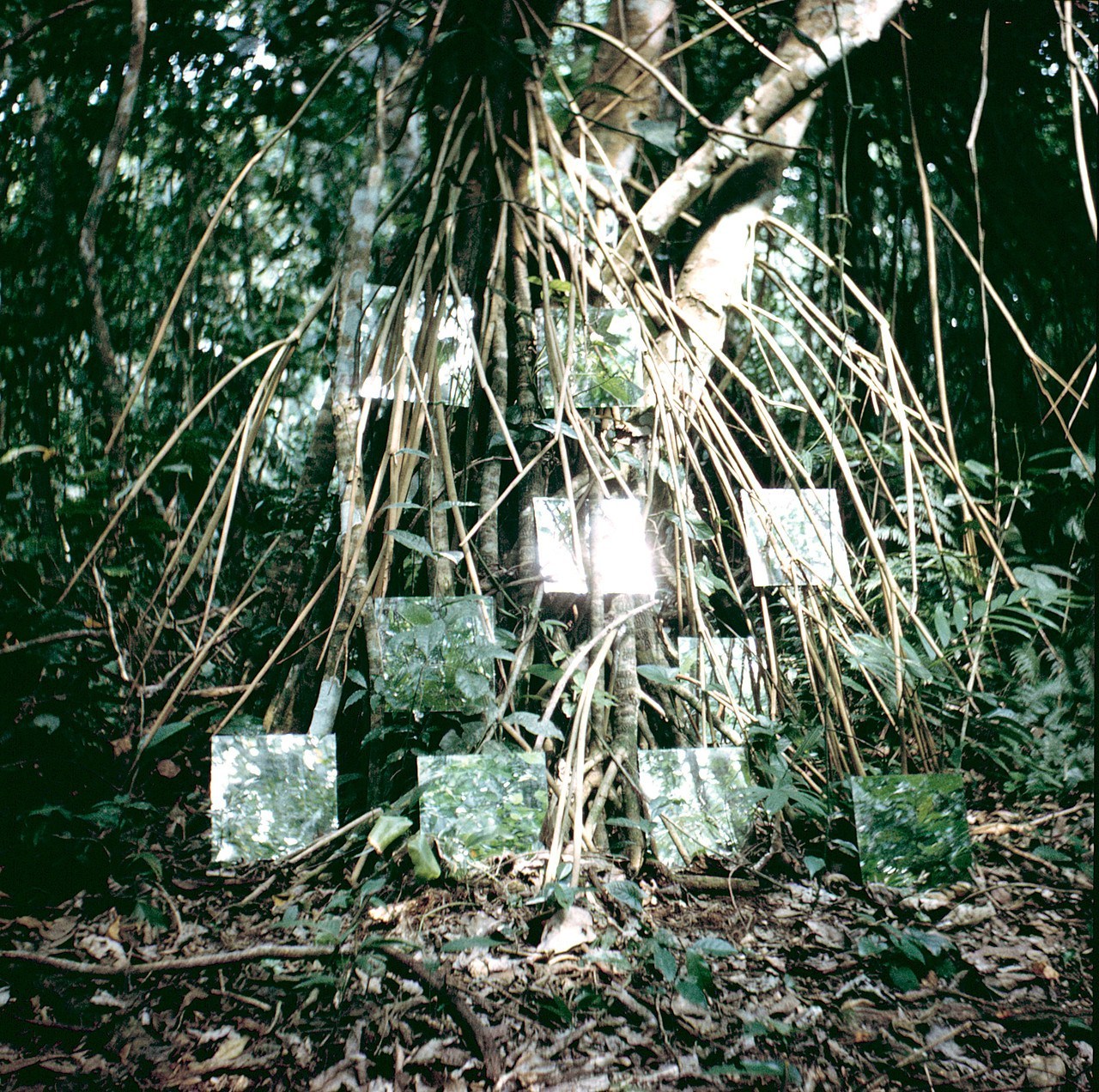Formal Analysis
This is a photograph of a tangled tree in a jungle on the Yucatan peninsula of Mexico with twelve square mirrors woven into the tree’s branches by the photographer, Robert Smithson.This is the seventh in a series of nine photos called ‘mirror displacements’ taken in 1969.The series was accompanied by an essay called ‘Incidents of Mirror-Travel in the Yucatan’.
A central bundle of grayish-brown trunks makes up the tree’s core which is surrounded by thin branches arcing downward and outward.These branches create a web of angled vertical lines that act as an infrastructure to hold the mirrors in place.The thickest middle portion of the trunk is a grounding point in an otherwise chaotic scene.The tree is rooted in the brown jungle floor at the lower quarter of the image and is surrounded by the green jungle to its left and right which is slightly out of focus.The mirrors have been roughly arranged in four rows and five columns, overall, the placement appears more random than neatly aligned. Nine of the twelve mirrors are plainly visible. According to the photographer “two have sunken into the shadow and one on the lower right is all but eclipsed” (Smithson 128).
There is a disorienting effect created by the mirrors which Smithson referred to as “displacement”. They capture a random combination of the green of the surrounding foliage and bits of light breaking through the leaves. The mirrors are recognizable by their machinemade squareness but also blend in by reflecting their surroundings and act to distort the lines of the tree. The photographer was not interested in a typical panoramic nature scene; he captured only the lower portion of the tree and very little of the surrounding context. The photo is taken slightly off-axis from the mirrors, which we can assume was done intentionally to stay out of their reflection and to capture the light as it reflected. On the third row, there’s a mirror jammed between two branches that flashes into dematerialization (Smithson 128). There is also some blurring of the photo which creates a faint sense of motion. This image was clearly not intended to be a serene landscape scene, but instead, a visceral communication with nature.
Historical Analysis
Robert Smithson was part of an art movement that took place in the late 1960s and early 1970s known as Land Art, which coincided with increasing popularity in the rejection of urban living. At the movement’s forefront was a group of artists mainly located in New York who were focused on getting out of galleries and creating large scale land sculptures on remote sites called ‘Earthworks’. All of Smithson’s artworks, including his mirror displacements, were focused on a discussion or “dialectic” with nature. He was deeply interested in experiencing and showcasing nature as it is and was critical of a common mindset where nature was expected to be “picturesque” instead of a real, constantly changing force.
“You have nature when it’s tranquil and then you have nature when it rages. A lot of people tend to have a Disneyland idea of nature, that somehow it’s all pastoral, but it isn’t. There are storms and there are other forces and there is an aspect that the closer you get to that, the more you develop a sense that there is a balance between what you would call tampering and things as they are” (Crump).
Smithson’s dialect with nature is clear in Seventh Mirror Displacement.Through the use of his mirrors, he added his own voice to the conversation with a jungle which he described as “shattered recesses with wild growths of creepers and weeds disclosing a broken geometry” (Smithson).
Contextual Analysis
The ‘Seventh Mirror Displacement’ falls into a category of art Smithson called ‘Nonsites‘. Nonsites are fragments taken from a landscape and framed within a gallery.They are intended to break down the polarity between inside and outside, leaving open the possibility of a third term that would contain both (Martin). He was focused on showcasing similarities and contrasts between natural and man-made environments and was concerned with concepts of sameness and entropy - the degradation of the matter and energy in the universe to an ultimate state of inert uniformity (Merriam-Webster). He suggested a philosophy, a political strategy, and a new role for the artist - that of an analyst who understands and can act to resolve social conflict (Martin 166).
Robert Smithson used mirrors to reflect and refract the surrounding environs, displacing the solidity of the landscape and shattering its forms (Spector). Part Earthwork and part image, his displacements contemplate temporality; while the mirror records the passage of time, its photograph suspends time (Spector). In his description of this work from ‘Incidents of Mirror-Travel in the Yucatan’, Smithson stated “Art brings sight to a halt, but that halt has a way of unraveling itself ” (129).
